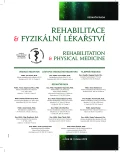Hand Arm Bimanual Intensive Therapy of Upper Extremities (HABIT) in Patients with Child Cerebral Palsy
Authors:
A. Rejtarová; J. Uhlířová; O. Švestková
Authors‘ workplace:
Klinika rehabilitačního lékařství 1. lékařské fakulty Univerzity Karlovy a Všeobecné fakultní nemocnice v Praze
Published in:
Rehabil. fyz. Lék., 26, 2019, No. 1, pp. 23-27.
Category:
Original Papers
Overview
Cerebral palsy is a disease that has an undeniable effect on activities of daily living. It is often associated with hemiparesis, a partial paralysis of one half of the body. Nowadays, there is a large variety of rehabilitation methods based on a very intensive training of the paretic upper limb. While a lot of these methods focus exclusively on the paretic upper limb, there are also less well-known methods exercising both the upper limbs simultaneously. One of such methods is HABIT (Hand Arm Bimanual Intensive Therapy). It is a method which is based on very intensive training of cooperative tasks performed by both upper limbs at the same time. Current research shows comparable results with methods such as CIMT (Constraint Induced Movement Therapy). Furthermore, HABIT does not require immobilization and it is therefore well tolerated even by children with cerebral palsy.
Keywords:
Cerebral palsy – habit – Bimanual therapy – upper limbs cooperation – hemiparesis – occupational therapy
Sources
1. AARTS, P., JONGERIUS, H. P., GEERDINK, A. Y., VAN LIMBEEK, J., GEURTS, C. A.: Modified constraint-induced movement therapy combined with bimanual training (mCIMT–BiT) in children with unilateral spastic cerebral palsy: How are improvements in arm-hand use established? Research in Developmental Disabilities[online], 32, 2011, 1, s. 271-279 [cit. 2018-07-22]. DOI: 10.1016/j.ridd.2010.10.008. ISSN 08914222. Dostupné z: http://linkinghub.elsevier.com/retrieve/pii/S0891422210002465.
2. ANGEROVÁ, Y.: Neurorehabilitace – úvodní slovo. Neurologie pro praxi, 2013 03 (02). Dostupné z: https://www.neurologiepropraxi.cz/pdfs/neu/2013/03/02.pdf.
3. CHARLES, J. GORDON, M. A.: Development of hand–arm bimanual intensive training (HABIT) for improving bimanual coordination in children with hemiplegic cerebral palsy. Developmental Medicine & Child Neurology [online], 48, 2006, 11, 931 [cit. 2018-07-22]. DOI: 10.1017/S0012162206002039. ISSN 0012-1622. Dostupné z: http://doi.wiley.com/10.1017/S0012162206002039.
4. GELKOP, N., BURSHTEIN, D. G., LAHAV, A., BREZNER, A., AL-ORAIBI, S., FERRE., L. C., GORDON, M. A.: Efficacy of constraint-iduced movement therapy and bimanual training in children with hemiplegic cerebral palsy in an educational setting. Physical & Occupational Therapy In Pediatrics [online], 35, 2014, 1, s. 24-39 [cit. 2018-07-22]. DOI: 10.3109/01942638.2014.925027. ISSN 0194-2638. Dostupné z: http://www.tandfonline.com/doi/full/10.3109/01942638.2014.925027.
5. GORDON, M. A., SCHNEIDER, J. A., CHINNAN A., CHARLES, R. J.: Efficacy of a hand-arm bimanual intensive therapy (HABIT) in children with hemiplegic cerebral palsy: a randomized control trial. Developmental Medicine & Child Neurology [online], 49, 2007, 11, s. 830-838 [cit. 2018-07-22]. DOI: 10.1111/j.1469-8749.2007.00830.x. ISSN 00121622. Dostupné z: http://doi.wiley.com/10.1111/j.1469-8749.2007.00830.x.
6. HUNG, Y, CASERTANO, L., HILLMAN, A., GORDON, M. A.: The effect of intensive bimanual training on coordination of the hands in children with congenital hemiplegia. Research in Developmental Disabilities [online,] 32, 2011, 6, s. 2724-2731 [cit. 2018-07-22]. DOI: 10.1016/j.ridd.2011.05.038. ISSN 08914222. Dostupné z: http://linkinghub.elsevier.com/retrieve/pii/S0891422211002241.
7. KWAKKEL, G., VEERBEEK M. J., VAN WEGEN, E., WOLF, L. S.: Constraint-induced movement therapy after stroke. The Lancet Neurology [online], 14, 2015, 2, s. 224-234 [cit. 2018-07-22]. DOI: 10.1016/S1474-4422(14)70160-7. ISSN 14744422. Dostupné z: http://linkinghub.elsevier.com/retrieve/pii/S1474442214701607.
8. LIPPERT-GRÜNER, M.: Neurorehabilitace. Praha, Galén, c2005. s. 60-62. ISBN 8072623176.
9. NEVŠÍMALOVÁ, S., TICHÝ, J., RŮŽIČKA, E.: Neurologie. Praha, Galén, s. 275-277, c2002, ISBN 80-7262-160-2.
10. ODDING, E., ROEBROECK, E. M., STAM, J. H.: The epidemiology of cerebral palsy: Incidence, impairments and risk factors. Disability and Rehabilitation [online], 28, 2009, 4, s. 183-191 [cit. 2018-07-22]. DOI: 10.1080/09638280500158422. ISSN 0963-8288. Dostupné z: http://www.tandfonline.com/doi/full/10.1080/09638280500158422.
11. SAKZEWSKI, L.: Bimanual therapy and constraint-induced movement therapy are equally effective in improving hand function in children with congenital hemiplegia. Journal of Physiotherapy[online], 58, 2012, 1, 59 [cit. 2018-07-22]. DOI: 10.1016/S1836-9553(12)70075-9. ISSN 18369553. Dostupné z: http://linkinghub.elsevier.com/retrieve/pii/S1836955312700759.
12. STAVSKY, M., MOR, O., MASTROLIA, S. A., GREENBAUM, S., THAN, N. G., EREZ, O.: Cerebral palsy—trends in epidemiology and recent development in prenatal mechanisms of disease, treatment, and prevention. Frontiers in Pediatrics [online], 2017, 5, [cit. 2018-07-22]. DOI: 10.3389/fped.2017.00021. ISSN 2296-2360. Dostupné z: http://journal.frontiersin.org/article/10.3389/fped.2017.00021/full.
13. SUNDERLAND, A., TUKE, A.: Neuroplasticity, learning and recovery after stroke: A critical evaluation of constraint-induced therapy. Neuropsychological Rehabilitation [online], 15, 2005, 2, s. 81-96 [cit. 2018-07-22]. DOI: 10.1080/09602010443000047. ISSN 0960-2011. Dostupné z: http://www.tandfonline.com/doi/abs/10.1080/09602010443000047.
14. ŠVESTKOVÁ, O., ANGEROVÁ Y., DRUGA R., PFEIFFER, J., VOTAVA, J.: Rehabilitace motoriky člověka: fyziologie a léčebné postupy. Praha, Grada Publishing, 2017. ISBN 978-80-271-0084-2.
15. TAUB, E., USWATTE, G., PIDIKITI, R.: Constraint-induced movement therapy: a new family of techniques with broad application to physical rehabilitation-a clinical review. Journal of Rehabilitation Research and Development [online], 36, 1999, 3, s. 237-251 [cit. 2018-07-22]. ISSN 07487711.
16. TAUB, E., USWATTE, G., MARK, V. W., MORRIS, D. M.: The learned nonuse phenomenon: implications for rehabilitation. Europa Medicophysica [online], 42, 2006, 3, s. 241-56 [cit. 2018-07-22]. ISSN 00142573.
17. TROJAN, S., POKORNÝ, J.: Theoretical aspects of neuroplasticity. Physiological Research[online], 48, 1999, 2, s. 87-97 [cit. 2018-07-22]. ISSN 08628408.
18. ÚZIS. Aktuální verze MKN-10 v ČR. ÚZIS: Ústav zdravotnických informací a statistiky [online]. © ÚZIS ČR, 2018 [cit. 2018-07-30]. Dostupné z: http://www.uzis.cz/zpravy/aktualni-verze-mkn-10-cr.
19. WOLF, L. S., WINSTEIN, J. C., MILLER, J. P. et al.: Effect of constraint-induced movement therapy on upper extremity function 3 to 9 months after stroke. JAMA [online], 296, 2006, 17, 2095-[cit. 2018-07-22]. DOI: 10.1001/jama.296.17.2095. ISSN 0098-7484. Dostupné z: http://jama.jamanetwork.com/article.aspx?doi=10.1001/jama.296.17.2095.
Labels
Physiotherapist, university degree Rehabilitation Sports medicineArticle was published in
Rehabilitation & Physical Medicine

2019 Issue 1
- Hope Awakens with Early Diagnosis of Parkinson's Disease Based on Skin Odor
- Deep stimulation of the globus pallidus improved clinical symptoms in a patient with refractory parkinsonism and genetic mutation
Most read in this issue
- Vacuum-compression therapy as part of spa treatment in post-traumatic conditions
- Dissection of Vertebral Artery as a Complication of Manipulation Therapy
- Chronic Non-specific Low Back Pain and Yoga as One of the Treatment Possibilities
- Ergotherapy Intervention on the Bed Iincluding Early Rehabilitation Influences Self-sufficiency and Duration of Hospitalization
